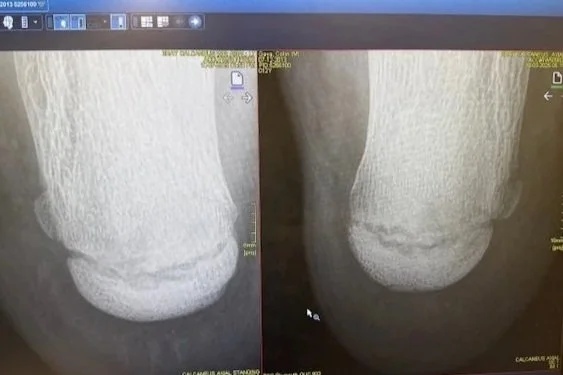Sever’s Disease: Growing Pains Manifesting as Tissue or Foot Injury!
My son Collin started experiencing right foot pain after soccer practice on a Tuesday night. We thought it would be resolved by the morning. The pain worsened to the point that standing on the right foot was intolerable by Friday morning. Orthopedic urgent care revealed that the X-rays (one is left photo above) were not conclusive for a fracture or other mechanical injury. We had him rest over the weekend and remain non-weight-bearing as we waited for a Tuesday appointment with the orthopedic surgeon. At that appointment, an X-ray of the left foot (right photo above) revealed similarities to the pained right foot, ruling out a definitive fracture. The findings were most consistent with Sever's Disease, inflammation at the growth plate or calcaneal apophysitis, matching the location of his right foot pain.
So what were we to do now? Sever's Disease, a type of growing pain, can be a frustrating diagnosis because there are no specific directives besides gauging your player's symptoms to determine when to go back to playing sports. For Collin, we created an intentional plan that included rest, the use of anti-inflammatory medications, and daily stretches to support him. Here are five things to consider once fractures and other mechanical problems have been eliminated to help your child athlete manage growing pains, such as Sever's Disease.
1. Rest and do not bear weight until weight-bearing is tolerable.
As we waited for the formal orthopedic surgeon visit, we had Collin not bear weight to prevent further worsening of any potential fracture or injury. He used a boot to immobilize the foot and a knee scooter to move around and attend school until his evaluation. Take the time off and skip games and active practice to avoid missing a whole season to prevent exacerbating a potential injury.
2. Start a systemic and topical anti-inflammatory routine if appropriate and tolerated.
Depending on your child’s age and weight, consider administering continuous oral anti-inflammatories around the clock (every 4 to 6 hours) to help alleviate inflammation and pain. Acetaminophen and ibuprofen can be used in addition to prescription nonsteroidal anti-inflammatories as recommended to help manage the pain. Over-the-counter topical diclofenac and lidocaine may also be helpful to treat inflammation and pain. Follow the indicated dosing guidelines to minimize side effects. Once your child returns to physical activity, prevent potential aggravation of growing pains by using anti-inflammatories before and after practices and matches.
3. Ice and elevate the foot consistently.
A staple approach to treating any initial musculoskeletal concern is to ice the affected area and elevate it above the level of the heart. Consider these two things as your child athlete rests to further naturally reduce inflammation. Do not leave ice on for too long to prevent tissue injury, such as cold burns. Avoid uncomfortable resting positions during elevation of the affected area.
4. Communicate with your child's community about his condition and the plan.
Ensure that your child’s coach, school, family, and community are aware of your child's condition and the plan to help him or her recover safely and swiftly. Your child should not feel isolated from their team or as if they are going through the experience alone. Nor should their commitment or dedication as an athlete be questioned due to a lack of unclear communication.
5. Follow up with a medical provider if your child does not improve or if symptoms worsen.
Have your child re-examined and update the recovery goals with your orthopedic surgeon or trusted provider. While Sever's Disease does not usually cause mechanical injury, changes can occur, such as avulsions at the growth plate, tendon strain, or other wear and tear that may impact recovery time. Further imaging, such as repeat X-ray or MRI, may be indicated to determine the extent of any injury and to guide the recovery plan. Do not delay further intervention if your child's symptoms worsen or do not improve over several weeks.
Every child athlete is unique and has different needs for growth and development. If suffering from persistent growing pains, like Sever's Disease, tailor your child’s recovery plan to meet their needs for a quicker recovery and to prevent potential long-term injury.


